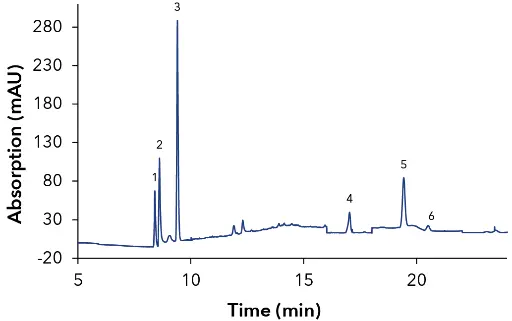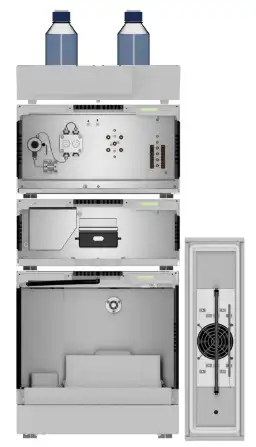
Science with Passion
Application No.: VFD0189 Version 1 10/2021
A, B, D, E – Simultaneous determination of water- and fat-soluble vitamins
Juliane Böttcher, Kate Monks; applications@knauer.net
KNAUER Wissenschaftliche Geräte GmbH, Hegauer Weg 38, 14163 Berlin

Foto: Fotolia
Summary
Vitamins are divided into two different groups: water-soluble and fat-soluble. The fat-soluble vitamins are A, D, E and K whereas the water-soluble vitamins are the vitamin C and vitamin B complexes. Based on their different chemical properties, they are usually analyzed using different methods and modes. Reversed phase HPLC is very common for the water-soluble vitamins whereas normal phase mode is often applied for the fat-soluble vitamins. Nevertheless, it is possible that the analytes can occur in the same matrix. For this reason, a simultaneous determination of both water- and fat-soluble vitamins was developed in this work, resulting in a reduction in solvent consumption and total analysis time, is desirable.
Introduction
Vitamins are essential nutrients and are needed for a healthy metabolism in the human body. They are naturally found in many foods and are often present as additives in processed food products. They can be broadly classified into two groups: water-soluble and fat-soluble vitamins. But what is the difference? One major difference is that they are absorbed into the bloodstream and metabolized in a different manner and excreted from the body at different rates. Water-soluble vitamins can be dissolved in water and readily absorbed into tissues for immediate use. Because they are not stored in the body, they need to be replenished regularly [1]. In contrast, fat-soluble vitamins are stored in the body for long periods of time and, as a result, pose a greater risk for toxicity than water-soluble vitamins when consumed in excess [2]. The following reversed phase method allows a simultaneous determination of three water-soluble (B2, B9, B12) and three fat-soluble (A, D3, E) vitamins.
Sample Preparation
Individual stock solutions were prepared. Standards of vitamins B2, B9 and B12 were dissolved in deionized water. The solutions for vitamin E and vitamin D3 were ready to use ampules with a concentration of β = 1 mg/ ml for each vitamin. Vitamin A palmitate stock solution was prepared by dissolving vitamin A palmitate in 100 % methanol.
Tab. 1 Concentrations of stock solutions
Analyte | Concentration | Concentration |
Vitamin B2 (riboflavin) | 135 | 13.50 |
Vitamin B9 (folic acid) | 115 | 11.50 |
Vitamin B12 (cyanocobalamin) | 100 | 10.00 |
Vitamin A palmitate | 218 | 21.80 |
Vitamin D3 | 1000 | 100.00 |
Vitamin E | 1000 | 100.00 |
With these single standards a mixed standard was prepared.
Tab. 2 Concentrations of analytes in mixed standard
Analyte | Volume stock solution (ml) | Total volume (ml) | Concentration Mix (µg/ml) | Concentration Mix (mg/100 g) |
Vitamin B2 | 1 | 4.30 | 31.40 | 3.14 |
Vitamin B9 | 1 | 4.30 | 26.74 | 2.67 |
Vitamin B12 | 1 | 4.30 | 23.26 | 2.33 |
Vitamin A palmitate | 1 | 4.30 | 50.70 | 5.07 |
Vitamin D3 | 0.1 | 4.30 | 23.26 | 2.33 |
Vitamin E | 0.2 | 4.30 | 46.51 | 4.65 |
Results
The mixed standard was measured with the listed method in the Materials and Method section. A 5-point calibration was performed, and all analytes showed good linearity with values of R2 > 0.9996.

Fig. 1 Chromatogram of mixed standard; (1) vitamin B2; (2) vitamin B9; (3) vitamin B12; (4) vitamin A palmitate; (5) vitamin D3; (6) vitamin E, UV detection with wavelength switching

Fig. 2 Calibration curves
Based on the measurement of the lowest calibration level, the LOQ (S/N=10) and the LOD (S/N=3) were calculated.
Tab. 3 Concentrations of calibration levels
Analyte | Level 1 | Level 2 | Level 3 | Level 4 | Level 5 |
Vitamin B2 | 3.14 | 6.28 | 10.47 | 15.70 | 31.40 |
Vitamin B9 | 2.67 | 5.35 | 8.92 | 13.37 | 26.74 |
Vitamin B12 | 2.33 | 4.65 | 7.75 | 11.63 | 23.26 |
Vitamin A palmitate | 5.07 | 10.14 | 16.90 | 25.35 | 50.70 |
Vitamin D3 | 2.33 | 4.65 | 7.75 | 11.63 | 23.26 |
Vitamin E | 4.65 | 9.30 | 15.50 | 23.26 | 46.51 |
Tab. 4 Calculated LOQ and LOD
Analyte | LOQ | LOQ | LOD | LOD |
Vitamin B2 | 0.010 | 1.00 | 0.003 | 0.30 |
Vitamin B9 | 0.029 | 3.00 | 0.009 | 0.90 |
Vitamin B12 | 0.038 | 4.00 | 0.011 | 1.10 |
Vitamin A palmitate | 0.668 | 67.00 | 0.200 | 20.00 |
Vitamin D3 | 0.040 | 4.00 | 0.012 | 1.20 |
Vitamin E | 0.465 | 47.00 | 0.140 | 14.00 |
Conclusion
The described method allows the simultaneous determination of water-soluble and fat-soluble vitamins. The challenge with this application is not the determination itself but finding an appropriate sample preparation procedure. The simultaneous method still requires the extraction of samples using two different methods that are suitable for each class of vitamins (dependent on their solubility). Nevertheless, no additional method for analysis is needed, meaning a reduction of solvent consumption and total analysis time is achievable. Furthermore, the analysis can be performed on a single reversed phased HPLC-System. A second normal phase HPLC-system is not necessary. In consequence, not only the cost for solvent consumption and analysis time are reduced, but also the cost for laboratory devices.
Materials and Methods
System configuration
Instrument | Description | Article No. |
Pump | AZURA P 6.1L, 10 ml, LPG | |
Autosampler | AZURA AS 6.1L with cooling/heating | |
Detector | AZURA DAD 6.1L | |
Flow cell | High Sensitivity KNAUER LightGuide UV Flow Cell Cartridge, 50 mm, 6 µL, 50 bar | |
Thermostat | AZURA CT 2.1 | |
Column | Eurospher II 100-3 C18P with precolumn, | |
Software | ClarityChrom 8.2.3 – Workstation, autosampler control included | |
Software | ClarityChrom 8.2.3 – PDA extension |
Method parameters
Parameter | Description | ||
Eluent A | Water + 0.01 % TFA (pH=4) | ||
Eluent B | Methanol | ||
Flow rate | 0.5 ml/min | ||
Temperature | 30° C | ||
Gradient | Time (min) | % A | % B |
0 | 95 | 5 | |
3 | 95 | 5 | |
12 | 0 | 100 | |
22 | 0 | 100 | |
22.02 | 95 | 5 | |
28 | 95 | 5 | |
Injection volume | 5 µl | ||
Detection | Wavelength program | ||
Time (min) | Wavelength (nm) | ||
0 | 360 | ||
8.50 | 270 | ||
16 | 318 | ||
18 | 270 | ||
20 | 292 | ||
22-28 | 360 | ||
Data rate | 20 Hz | ||
Time constant | 0.05 s |

References
[1] https://www.verywellhealth.com/fat-vs-water-soluble-998218, 2021-09-27
[2] Fat-Soluble Vitamins: A, D, E, and K; Fact Sheet No. 9.315, Food and Nutrition Series/Health, https://extension.colostate.edu/topic-areas/nutrition-food-safety-health/fat-soluble-vitamins-a-d-e-and-k-9-315/, 2021-09-27
Related KNAUER Applications
VFD0172 – A D E K – Easy separation of fat-soluble vitamins using GPC/SEC
VFD0162 – Separation of ascorbic acid and vitamin B complexes – essentially required nutrients
Application details
|
Method |
HPLC |
|
Mode |
RP |
|
Substances |
Vitamin B12, vitamin B2, vitamin B9, vitamin E, vitamin D3, vitamin A palmitate |
|
CAS number |
68-19-9, 83-88-5, 59-30-3, 10191-41-0, 67-97-0, 79-81-2 |
|
Version |
Application No.: VFD0189 | Version 1 10/2021 | ©KNAUER Wissenschaftliche Geräte GmbH |


